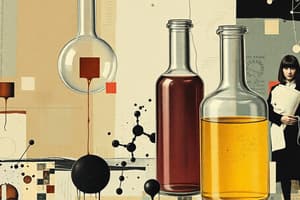Podcast
Questions and Answers
Which of the following is the best example of the law of conservation of energy?
Which of the following is the best example of the law of conservation of energy?
- A lightbulb produces light without any other form of energy input.
- Burning wood completely disappears, showing that its energy is completely annihilated.
- A battery slowly loses its charge over time, indicating that energy is being destroyed.
- A car engine converts chemical energy into kinetic energy, with some energy lost as heat due to friction. (correct)
Which of the following would NOT be considered matter?
Which of the following would NOT be considered matter?
- Water
- Light (correct)
- Air
- A rock
A chemist is trying to identify an unknown transparent liquid. Which of the following properties would be most useful in determining if the liquid is a pure substance or a mixture?
A chemist is trying to identify an unknown transparent liquid. Which of the following properties would be most useful in determining if the liquid is a pure substance or a mixture?
- Color
- Volume
- Mass
- Boiling point range (correct)
Why is density considered a reliable property for identifying a substance, such as determining if a coin is truly gold?
Why is density considered a reliable property for identifying a substance, such as determining if a coin is truly gold?
Why is the presence of oxygen crucial when testing the flammability of a substance?
Why is the presence of oxygen crucial when testing the flammability of a substance?
Which scenario provides the best example of a chemical change?
Which scenario provides the best example of a chemical change?
Considering the kinetic theory of matter, how does increasing the temperature of a gas in a closed container affect the motion of its particles?
Considering the kinetic theory of matter, how does increasing the temperature of a gas in a closed container affect the motion of its particles?
Dry ice (solid carbon dioxide) turning directly into gaseous carbon dioxide is an example of which phase change?
Dry ice (solid carbon dioxide) turning directly into gaseous carbon dioxide is an example of which phase change?
Flashcards
Properties of Matter
Properties of Matter
All matter must have mass and volume.
Law of Conservation of Energy
Law of Conservation of Energy
Energy cannot be created or destroyed, only changes form.
Pure Substance vs Mixture
Pure Substance vs Mixture
A pure substance has a consistent composition; a mixture’s composition can vary.
Heterogeneous vs Homogeneous Mixture
Heterogeneous vs Homogeneous Mixture
Signup and view all the flashcards
Phase Changes - Endothermic
Phase Changes - Endothermic
Signup and view all the flashcards
Phase Changes - Exothermic
Phase Changes - Exothermic
Signup and view all the flashcards
Physical Change vs Chemical Change
Physical Change vs Chemical Change
Signup and view all the flashcards
Kinetic Theory
Kinetic Theory
Signup and view all the flashcards
Study Notes
Matter and Its Properties
- All matter has mass and volume.
- Energy cannot be created or destroyed, only changed.
- Light, heat, and sound are examples of things that exist but are not considered matter.
Substances and Mixtures
- A pure substance has a fixed composition.
- A mixture has a variable composition.
- Heterogeneous mixtures have visibly different components.
- Homogeneous mixtures have uniform composition.
- Salad dressing is heterogeneous because particles are different sizes.
- Salt water is homogeneous because particles are similar and dissolved.
Physical vs. Chemical Properties
- Density is a physical property used to identify a substance.
- Flammability is a chemical property that requires oxygen for testing.
- Reactivity describes how easily a substance combines with others.
- Examples include chemical reactions like mixing vinegar and milk, or the dangerous reaction of windex and bleach, or mustard gas.
- A physical change alters a substance's appearance but not its composition.
- A chemical change results in a new substance with different characteristics.
- Mixing vinegar and milk is a chemical change, producing a precipitate.
- Ice melting is a physical change, as water remains water.
States of Matter
- Solids: Definite shape and volume.
- Liquids: Indefinite shape and definite volume.
- Gases: Indefinite shape and indefinite volume.
Kinetic Theory
- The kinetic theory explains that all matter is constantly in motion.
- Heating increases the motion of particles in matter.
Phase Changes
- Endothermic phase changes: Melting, vaporization, and sublimation.
- Exothermic phase changes: Freezing, condensation, and deposition.
- Sublimation: A direct change from solid to gas.
- Condensation: The phase change from gas to liquid.
- Condensation occurs when a glass of ice tea is held, making the outside of the glass wet.
Phase Change Graphs
- The flat portions of phase change graphs represent phase changes.
- During phase changes energy is used for either separating or putting atoms together.
- The flat line is called melting when heating, and freezing when cooling a substance.
Gas Laws
-
Factors affecting gas pressure (in a closed container): Volume, temperature, number of particles.
-
Boyle's Law: Pressure and volume are inversely related.
-
Charles' Law: Volume and temperature are directly related.
-
Gay-Lussac's Law: Pressure and temperature are directly related.
Gas Law Calculations
- Temperature for gas law calculations needs to be in Kelvins.
- Example Boyle's Law problem: If the volume of a cylinder reduces from 10L to 5L, the pressure will change from 50 kPa to 100 kPa.
- Example Charles' Law problem: If a gas has a volume of 15L at 200K and decreases to 7L, the new temperature is approximately 93.3K
Studying That Suits You
Use AI to generate personalized quizzes and flashcards to suit your learning preferences.




